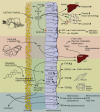Dietary lipids, gut microbiota and lipid metabolism
- PMID: 31707624
- PMCID: PMC6938793
- DOI: 10.1007/s11154-019-09512-0
Dietary lipids, gut microbiota and lipid metabolism
Abstract
The gut microbiota is a central regulator of host metabolism. The composition and function of the gut microbiota is dynamic and affected by diet properties such as the amount and composition of lipids. Hence, dietary lipids may influence host physiology through interaction with the gut microbiota. Lipids affect the gut microbiota both as substrates for bacterial metabolic processes, and by inhibiting bacterial growth by toxic influence. The gut microbiota has been shown to affect lipid metabolism and lipid levels in blood and tissues, both in mice and humans. Furthermore, diseases linked to dyslipidemia, such as non-alcoholic liver disease and atherosclerosis, are associated with changes in gut microbiota profile. The influence of the gut microbiota on host lipid metabolism may be mediated through metabolites produced by the gut microbiota such as short-chain fatty acids, secondary bile acids and trimethylamine and by pro-inflammatory bacterially derived factors such as lipopolysaccharide. Here we will review the association between gut microbiota, dietary lipids and lipid metabolism.
Keywords: Atherosclerosis; Bile acid; Diet; Dietary lipid; Dysbiosis; Dyslipidemia; FXR; Fatty acid; Gut microbiota; Gut permeability; Inflammation; LPS; Lipid; Lipid metabolism; Lipopolysaccharides; Microbiome; NAFLD; Non-alcoholic liver disease; TGR5; TMA; TMAO; Trimethylamine N-oxide.
Conflict of interest statement
The authors declare that they have
Figures


References
-
- Vrieze Anne, Van Nood Els, Holleman Frits, Salojärvi Jarkko, Kootte Ruud S., Bartelsman Joep F.W.M., Dallinga–Thie Geesje M., Ackermans Mariette T., Serlie Mireille J., Oozeer Raish, Derrien Muriel, Druesne Anne, Van Hylckama Vlieg Johan E.T., Bloks Vincent W., Groen Albert K., Heilig Hans G.H.J., Zoetendal Erwin G., Stroes Erik S., de Vos Willem M., Hoekstra Joost B.L., Nieuwdorp Max. Transfer of Intestinal Microbiota From Lean Donors Increases Insulin Sensitivity in Individuals With Metabolic Syndrome. Gastroenterology. 2012;143(4):913-916.e7. doi: 10.1053/j.gastro.2012.06.031. - DOI - PubMed
-
- Koutnikova H, Genser B, Monteiro-Sepulveda M, Faurie J-M, Rizkalla S, Schrezenmeir J et al. Impact of bacterial probiotics on obesity, diabetes and non-alcoholic fatty liver disease related variables: a systematic review and meta-analysis of randomised controlled trials. 2019;9(3):e017995. doi:10.1136/bmjopen-2017-017995 %J BMJ Open. - PMC - PubMed
Publication types
MeSH terms
Substances
LinkOut - more resources
Full Text Sources
Other Literature Sources

